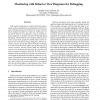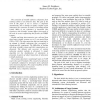41 search results - page 4 / 9 » Object naming analysis for reverse-engineered sequence diagr... |
JSW
2008
13 years 7 months ago
2008
An estimation of change-proneness of parts of a software system is an active topic in the area of software engineering. Such estimates can be used to predict changes to different c...
ECMDAFA
2010
Springer
13 years 10 months ago
2010
Springer
Dynamic UML models like sequence diagrams (SD) lack sufficient formal semantics, making it difficult to build automated tools for their analysis, simulation and validation. A commo...
APSEC
2005
IEEE
14 years 1 months ago
2005
IEEE
UML sequence diagrams are widely used during requirements analysis and design for specifying the expected message exchanges among a set of objects in various scenarios for the pro...
WCRE
1996
IEEE
13 years 11 months ago
1996
IEEE
The extraction of reusable software components from existing systems is an attractive idea. The goal of the work in this paper is not to extract a component automatically, but to ...
ACSC
2006
IEEE
14 years 1 months ago
2006
IEEE
Code obfuscation is a relatively new technique of software protection and it works by deterring reverse engineering attempts by malicious users of software. The objective of obfus...


